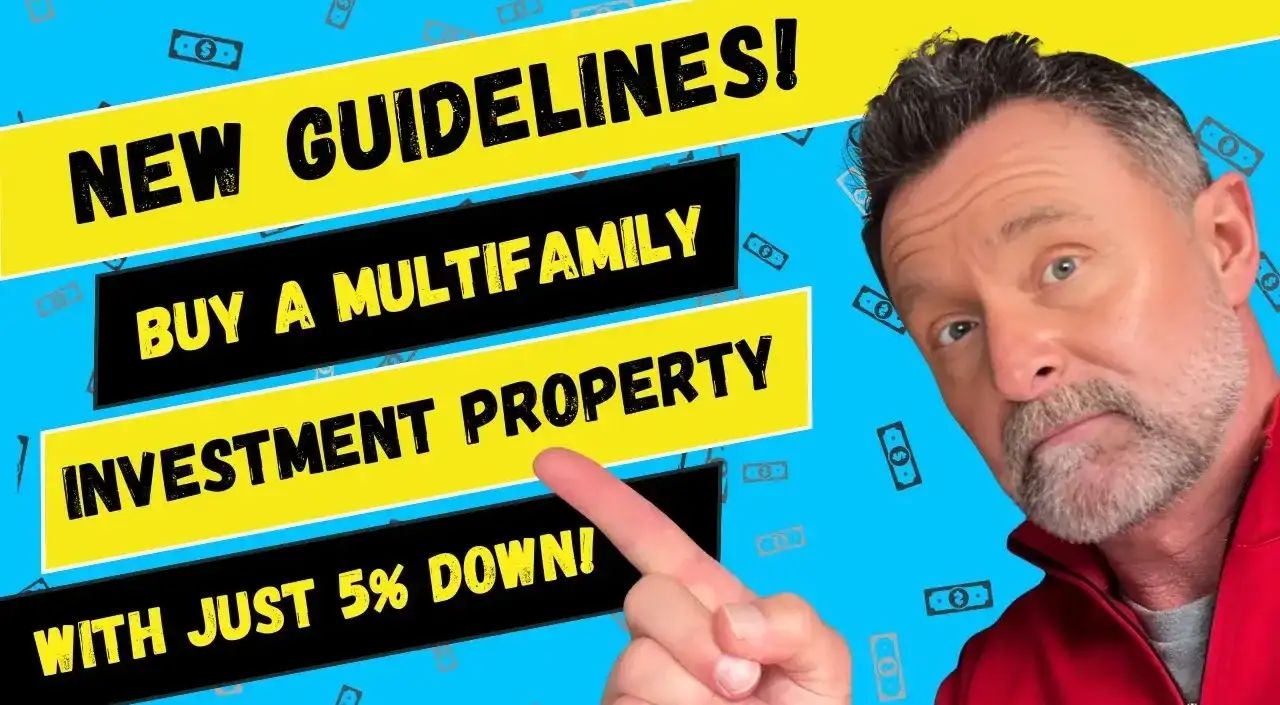Fannie Mae Rolls Out 5% Down Multifamily Home Loans

Fannie Mae allows buyers to purchase 2- to 4-unit multifamily homes with just 5% down, making it easier for house hackers and first-time investors to get started. With no self-sufficiency test and the ability to use future rental income to qualify, this program offers a practical path to multifamily homeownership.
Fannie Mae allows 5% down payments for owner-occupied 2-, 3-, and 4-unit (multifamily) homes.
This reversed the agency’s years-long policy of requiring 15-25% down for duplexes, triplexes, and four-plexes. It’s also a major benefit to those looking to purchase a multifamily home to live in while earning investment income as a landlord, known as “house hacking.”
5% Down Multifamily Loans Explained
Before the change, a two-unit home (duplex) required 15% down, and 3-4 unit homes required 25% down. Both property type down payments have been reduced to just 5%.
Previous down payment levels hindered many would-be owner-landlords. Especially since these properties are much more expensive than a typical single-family home.
To put that change into perspective, a $500,000 triplex required a $125,000 down payment. But as of November 18, 2023, only 5% down is required, or $25,000, a difference of $100,000 in this case.
The following are additional examples of reduced down payments needed.
2-Unit | 3-4 Unit | |
Example home price | $400,000 | $500,000 |
Min. down payment before 11/18/23 | $60,000 (15%) | $125,000 (25%) |
Min. down payment after 11/18/23 | $20,000 (5%) | $25,000 (5%) |
Upfront cash reduction | $40,000 | $100,000 |
The changes apply to standard purchases, no-cash-out refinances, HomeReady, and HomeStyle Renovation loans for owner-occupied transactions.
Cash needed, including reserves:
The down payment isn't the only up-front cash needed. You will need:
Down payment (5% of purchase price)
Closing costs (around 2%-4% of purchase price)
Reserves (6 months of the full monthly mortgage payment)
A big caveat to the 5% down multifamily program is that Fannie Mae requires six months of monthly mortgage payments to be kept in reserve (after paying the down payment and closing costs. You must prove you have this amount in an accessible account.
For example, a $400,000 duplex would require a $20,000 down payment and about $12,000 in closing costs upfront and $21,000 in reserve after closing (assuming a $3,500 full monthly payment). That means you’d need $53,000 total in savings, checking, and other accounts to qualify.
What Does This Mean for Multifamily Homebuyers?
Currently, the only other low-down-payment multifamily home loan you can get (if you don't have eligible military service) is an FHA loan. For just 3.5% down, buyers can own a 1-4-unit home.
For duplexes, FHA works well. But FHA comes with a serious drawback for 3-4 unit properties: the self-sufficiency test. In this test, the property must generate enough rental income to cover the entire payment after a vacancy factor of 25% (or the property not being rented at least 25% of the year). For example, a 4-unit home with a $5,000-per-month full payment would need market rents of nearly $6,700 per month.
With mortgage rates elevated, virtually no property can pass FHA’s test.
But with Fannie Mae 5% down conventional option with no self-sufficiency requirement, many buyers might qualify for financing on a 3-4 unit property.
First-time buyers, house hackers, and those who just want to offset high mortgage payments by renting out units might finally have a chance at homeownership and real estate investing.
Learn more about FHA multifamily loans here.
Can First-Time Buyers Use Rental Income to Qualify?
In most cases, even first-time buyers can use rental income from a 2-4 unit property to help them qualify. However, you must have a current housing expense (i.e. you must be paying rent).
Those living rent-free can't use future rental income to qualify for the loan.
Current renters who have no history of landlord experience can use future rental income to qualify, up to the amount of the full house payment.
Example: Using future rental income to qualify | |
Employment income | $7,000 per month |
Future rental income from units you won't live in less 25% vacancy factor | $3,000 |
Full payment incl. taxes, insurance, etc. | $3,500 |
Total qualifying income | $10,000 |
Because the borrower's future rental income is less than the monthly payment, she can add it to her employment income, less a 25% vacancy factor.
Future rental income goes a long way toward helping you qualify for higher home prices and mortgage rates in the market today.
Maximum Loan Amount $1,551,250 (No High-Balance)
The announcement states that the change only applies to standard conforming loan amounts, not increased loan amounts in high-cost areas, known as high-balance loans.
Still, this gives buyers plenty of room to purchase an expensive property, thanks to increased limits for 2-4 unit properties. Limits in 2025 are as follows.
Units | Maximum Loan Amount 2025 |
2-unit | $1,032,650 |
3-unit | $1,248,150 |
4-unit | $1,551,250 |
Other Eligibility Requirements
To qualify for this program, you'll typically need:
A credit score of at least 620, though a higher score can improve your rate.
A debt-to-income (DTI) ratio below 45% in most cases.
Proof of stable income and employment.
Enough cash to cover the 5% down payment, closing costs, and 6 months of reserves.
While these are standard guidelines, each lender may have slightly different overlays — so it’s worth shopping around and getting prequalified to see where you stand.
How Do Homebuyers Apply?
Interested homebuyers can apply now through a conventional lender that offers multifamily financing. Make sure to shop mortgage rates and terms with at least three or four different lenders, and ensure the brokers or loan officers you speak to have experience with Fannie Mae’s 5% down multifamily product.





